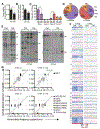Variable clonal repopulation dynamics influence chemotherapy response in colorectal cancer
- PMID: 23239622
- PMCID: PMC9747244
- DOI: 10.1126/science.1227670
Variable clonal repopulation dynamics influence chemotherapy response in colorectal cancer
Abstract
Intratumoral heterogeneity arises through the evolution of genetically diverse subclones during tumor progression. However, it remains unknown whether cells within single genetic clones are functionally equivalent. By combining DNA copy number alteration (CNA) profiling, sequencing, and lentiviral lineage tracking, we followed the repopulation dynamics of 150 single lentivirus-marked lineages from 10 human colorectal cancers through serial xenograft passages in mice. CNA and mutational analysis distinguished individual clones and showed that clones remained stable upon serial transplantation. Despite this stability, the proliferation, persistence, and chemotherapy tolerance of lentivirally marked lineages were variable within each clone. Chemotherapy promoted the dominance of previously minor or dormant lineages. Thus, apart from genetic diversity, tumor cells display inherent functional variability in tumor propagation potential, which contributes to both cancer growth and therapy tolerance.
Figures



Comment in
-
Intratumor heterogeneity: finding the needle in a haystack for cancer treatment.Gastroenterology. 2013 Jul;145(1):242-244. doi: 10.1053/j.gastro.2013.05.031. Epub 2013 May 29. Gastroenterology. 2013. PMID: 23726878 No abstract available.
-
Tumor heterogeneity and response to chemotherapy.Pharmacogenomics. 2013 Dec;14(16):1949. doi: 10.2217/pgs.13.175. Pharmacogenomics. 2013. PMID: 24279849 No abstract available.
Similar articles
-
Tumor heterogeneity and response to chemotherapy.Pharmacogenomics. 2013 Dec;14(16):1949. doi: 10.2217/pgs.13.175. Pharmacogenomics. 2013. PMID: 24279849 No abstract available.
-
Genetic subclone architecture of tumor clone-initiating cells in colorectal cancer.J Exp Med. 2017 Jul 3;214(7):2073-2088. doi: 10.1084/jem.20162017. Epub 2017 Jun 1. J Exp Med. 2017. PMID: 28572216 Free PMC article.
-
Spatiotemporal regulation of clonogenicity in colorectal cancer xenografts.Proc Natl Acad Sci U S A. 2019 Mar 26;116(13):6140-6145. doi: 10.1073/pnas.1813417116. Epub 2019 Mar 8. Proc Natl Acad Sci U S A. 2019. PMID: 30850544 Free PMC article.
-
Intratumoral functional heterogeneity and chemotherapy.World J Gastroenterol. 2014 Mar 14;20(10):2429-32. doi: 10.3748/wjg.v20.i10.2429. World J Gastroenterol. 2014. PMID: 24627580 Free PMC article. Review.
-
Intratumor heterogeneity: A new perspective on colorectal cancer research.Cancer Med. 2020 Oct;9(20):7637-7645. doi: 10.1002/cam4.3323. Epub 2020 Aug 27. Cancer Med. 2020. PMID: 32853464 Free PMC article. Review.
Cited by
-
Intercellular transfer of multidrug resistance mediated by extracellular vesicles.Cancer Drug Resist. 2024 Sep 21;7:36. doi: 10.20517/cdr.2024.84. eCollection 2024. Cancer Drug Resist. 2024. PMID: 39403600 Free PMC article. Review.
-
A unique interplay of access and selection shapes peritoneal metastasis evolution in colorectal cancer.bioRxiv [Preprint]. 2024 Sep 27:2024.09.25.614736. doi: 10.1101/2024.09.25.614736. bioRxiv. 2024. PMID: 39386634 Free PMC article. Preprint.
-
Forward-reverse mutation cycles in cancer cell lines under chemical treatments.Hum Genomics. 2024 Sep 27;18(1):106. doi: 10.1186/s40246-024-00661-1. Hum Genomics. 2024. PMID: 39334413 Free PMC article.
-
The roles of patient-derived xenograft models and artificial intelligence toward precision medicine.MedComm (2020). 2024 Sep 25;5(10):e745. doi: 10.1002/mco2.745. eCollection 2024 Oct. MedComm (2020). 2024. PMID: 39329017 Free PMC article. Review.
-
The signaling cascade of induction and maintenance of ES cell diapause.Res Sq [Preprint]. 2024 Sep 3:rs.3.rs-4946357. doi: 10.21203/rs.3.rs-4946357/v1. Res Sq. 2024. PMID: 39281867 Free PMC article. Preprint.
References
Publication types
MeSH terms
Grants and funding
LinkOut - more resources
Full Text Sources
Other Literature Sources
Medical


